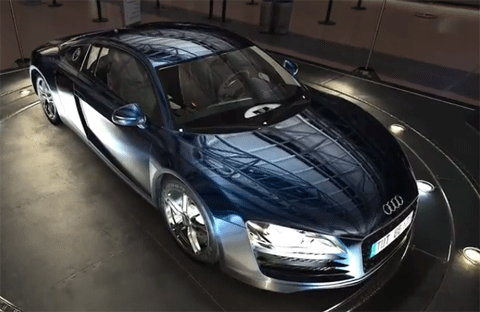
TeamUp’s Multi-Optics software uses real time physics-based rendering to enable teams to collaborate in a web-based interface.
For some designers and engineers, rendering is like buying new tyres for the car. It’s something that has to be done, but there’s no surplus of love for the process.
Fortunately, rendering, once interruptive to a fault, keeps getting faster, easier and more naturalistic. Do we dare say it can even be fun? You might believe just that if you witnessed some of the demos on the show floor at Siggraph 2012.
Crossing the chasm
Al Dean has blogged about the big announcements made by Luxion at Siggraph 2012. Thomas Teger, the company’s VP of marketing, says that rendering as a service and new interactive capabilities in KeyShot VR are bridging the gap between design and marketing.
According to Teger, companies are increasingly taking models from their CAD software, running them through software such as KeyShot and turning them into marketing collateral. Design and marketing still might not want to do lunch together, but they are becoming united via easy-to-use and convenient photorealistic rendering.
Collaboration with physics
Collaboration is the theme of a new company aptly named TeamUp, which showed its Multi-Optics software with physics-based rendering. Using the Multi-Optics web-based interface, teams of product designers anywhere in the world with a good web connection can share ideas, apply hundreds of materials to CAD models and see the results in real-time. Full collaboration is available on common laptop systems and reviewing can be done on tablets and smart phones.
Physics-based rendering is also at the center of a new offering by Optis called Theia-RT. Again, the idea is to use real-time rendering to make collaborative decisions on materials, lighting and surrounding environments.

theia-RT is a new real-time visualisation tool that helps users make decisions on material, appearance, mood lighting, perceived quality and lit effects.
A Caustic view
Imagination Technologies is showing off the fruit of its purchase of Caustic Graphics in December 2010. The company is demoing its Caustic Visualizer viewport plug-in for Autodesk Maya 2013. Imagination says that Caustic Visualizer “gives artists a new way to interact with content created in Maya, using an interactive, fully ray-traced viewport, complete with accurate global illumination, shadows and reflections.”
Lightworks strikes back
Long-time CAD rendering specialist Lightworks, whose rendering technology is embedded in more than 80 applications, isn’t about to be left behind. On the Siggraph exhibition floor the company is showing 3D stereoscopic rendering combining its Lightworks Artisan product with AMD FirePro GPUs. Sharing the booth is BeLight Software, which is demoing its Render Boost product based on Artisan.

Lightworks demonstrations
GPU ray tracing for the common man
A newcomer to what’s becoming a crowded party is CentiLeo. The company claims that it has the first GPU ray tracer that can handle huge texture-filled scenes on a consumer computer with a single processor.
Is love in the future?
At Jon Peddie Research’s annual Siggraph press luncheon, the theme was “Doing More with Multicore.” Phillip Miller of Nvidia acknowledged that hardware companies needed to work more closely with software companies to help them optimise their code to take advantage of multi-core processing.
No doubt there’s a lot more work to be done, but by the looks of the Siggraph 2012 show floor efforts are going at full throttle. Who knows, maybe in a few years rendering will win over the hearts of every designer and engineer.
Bob Cramblitt (www.cramco.com) writes about developments in CAD/CAM and computer graphics that can make a definitive difference for design and engineering professionals.






